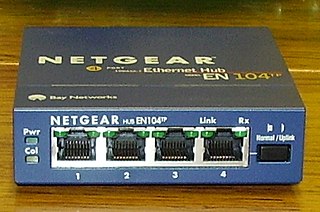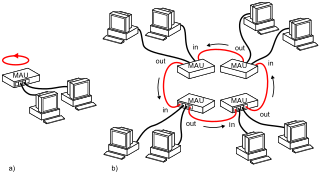Related Research Articles

Ethernet is a family of wired computer networking technologies commonly used in local area networks (LAN), metropolitan area networks (MAN) and wide area networks (WAN). It was commercially introduced in 1980 and first standardized in 1983 as IEEE 802.3. Ethernet has since been refined to support higher bit rates, a greater number of nodes, and longer link distances, but retains much backward compatibility. Over time, Ethernet has largely replaced competing wired LAN technologies such as Token Ring, FDDI and ARCNET.

A local area network (LAN) is a computer network that interconnects computers within a limited area such as a residence, school, laboratory, university campus or office building. By contrast, a wide area network (WAN) not only covers a larger geographic distance, but also generally involves leased telecommunication circuits.
100BaseVG is a 100 Mbit/s Ethernet standard specified to run over four pairs of Category 3 cable. It is also called 100VG-AnyLAN because it was defined to carry both Ethernet and Token Ring frame types.

Ethernet over twisted-pair technologies use twisted-pair cables for the physical layer of an Ethernet computer network. They are a subset of all Ethernet physical layers.

Network topology is the arrangement of the elements of a communication network. Network topology can be used to define or describe the arrangement of various types of telecommunication networks, including command and control radio networks, industrial fieldbusses and computer networks.

Category 5 cable (Cat 5) is a twisted pair cable for computer networks. Since 2001, the variant commonly in use is the Category 5e specification (Cat 5e). The cable standard provides performance of up to 100 MHz and is suitable for most varieties of Ethernet over twisted pair up to 2.5GBASE-T but more commonly runs at 1000BASE-T speeds. Cat 5 is also used to carry other signals such as telephone and video.

In computer networking, Fast Ethernet physical layers carry traffic at the nominal rate of 100 Mbit/s. The prior Ethernet speed was 10 Mbit/s. Of the Fast Ethernet physical layers, 100BASE-TX is by far the most common.

In computer networking, Gigabit Ethernet is the term applied to transmitting Ethernet frames at a rate of a gigabit per second. The most popular variant, 1000BASE-T, is defined by the IEEE 802.3ab standard. It came into use in 1999, and has replaced Fast Ethernet in wired local networks due to its considerable speed improvement over Fast Ethernet, as well as its use of cables and equipment that are widely available, economical, and similar to previous standards. The first standard for faster 10 Gigabit Ethernet was approved in 2002.
Category 3 cable, commonly known as Cat 3 or station wire, and less commonly known as VG or voice-grade, is an unshielded twisted pair (UTP) cable used in telephone wiring. It is part of a family of standards defined jointly by the Electronic Industries Alliance (EIA) and the Telecommunications Industry Association (TIA) and published in TIA/EIA-568-B.
StarLAN was the first IEEE 802.3 standard for Ethernet over twisted pair wiring. It was standardized by the IEEE Standards Association as 802.3e in 1986, as the 1BASE5 version of Ethernet. The StarLAN Task Force was chaired by Bob Galin.
Long Reach Ethernet (LRE) was a proprietary networking protocol marketed by Cisco Systems, intended to support multi-megabit performance over telephone-grade unshielded twisted pair wiring over distances up to 5,000 feet (1.5 km). Supporting such distance ranges, LRE is technically classified as a Metropolitan area network (MAN) technology. Technically the protocol was similar to very-high-bitrate digital subscriber line (VDSL), practically Ethernet over VDSL (EoVDSL).
SynOptics Communications was a Santa Clara, California-based early computer network equipment vendor from 1985 until 1994. SynOptics popularized the concept of the modular Ethernet hub and high-speed Ethernet networking over copper twisted-pair and fiber optic cables.

An Ethernet hub, active hub, network hub, repeater hub, multiport repeater, or simply hub is a network hardware device for connecting multiple Ethernet devices together and making them act as a single network segment. It has multiple input/output (I/O) ports, in which a signal introduced at the input of any port appears at the output of every port except the original incoming. A hub works at the physical layer. A repeater hub also participates in collision detection, forwarding a jam signal to all ports if it detects a collision. In addition to standard 8P8C ("RJ45") ports, some hubs may also come with a BNC or an Attachment Unit Interface (AUI) connector to allow connection to legacy 10BASE2 or 10BASE5 network segments.
An Ethernet crossover cable is a crossover cable for Ethernet used to connect computing devices together directly. It is most often used to connect two devices of the same type, e.g. two computers or two switches to each other. By contrast, straight through patch cables are used to connect devices of different types, such as a computer to a network switch.

The physical-layer specifications of the Ethernet family of computer network standards are published by the Institute of Electrical and Electronics Engineers (IEEE), which defines the electrical or optical properties and the transfer speed of the physical connection between a device and the network or between network devices. It is complemented by the MAC layer and the logical link layer. An implementation of a specific physical layer is commonly referred to as PHY.
Ethernet in the first mile (EFM) refers to using one of the Ethernet family of computer network technologies between a telecommunications company and a customer's premises. From the customer's point of view, it is their first mile, although from the access network's point of view it is known as the last mile.

Token Ring is a physical and data link layer computer networking technology used to build local area networks. It was introduced by IBM in 1984, and standardized in 1989 as IEEE 802.5. It uses a special three-byte frame called a token that is passed around a logical ring of workstations or servers. This token passing is a channel access method providing fair access for all stations, and eliminating the collisions of contention-based access methods.
Ronald V. Schmidt was an American computer network engineer.

The OPEN Alliance is a non-profit, special interest group (SIG) of mainly automotive industry and technology providers collaborating to encourage wide scale adoption of Ethernet-based communication as the standard in automotive networking applications.
Classic Ethernet is a family of 10 Mbit/s Ethernet standards, which is the first generation of Ethernet standards. In 10BASE-X, the 10 represents its maximum throughput of 10 Mbit/s, BASE indicates its use of baseband transmission, and X indicates the type of medium used. Classic Ethernet includes coax, twisted pair and optical variants. The first Ethernet standard was published in 1983 and classic Ethernet operating at 10 Mbit/s was the dominant form of Ethernet until the first standard for Fast Ethernet was approved in 1995.
References
- 1 2 Urs von Burg (2001). "The Battle Between Ethernet and Token Ring". The Triumph of Ethernet. Stanford University Press. ISBN 0-8047-4094-1.
- ↑ R. Schmidt; E. Rawson; R. Norton Jr.; S. Jackson; M. Bailey (November 1983). "Fibernet II: A Fiber Optic Ethernet". IEEE Journal on Selected Areas in Communications. 1 (5): 702. doi:10.1109/JSAC.1983.1145992.
- 1 2 3 Paula Musich (August 3, 1987). "User lauds SynOptic system: LattisNet a success on PDS". Network World. Vol. 4, no. 31. pp. 2, 39. Retrieved June 10, 2011.
- ↑ Eric Killorin (November 2, 1987). "LattisNet makes the grade in Novell benchmark tests". Vol. 4, no. 44. Network World. p. 19. Retrieved June 11, 2011.
- ↑ Charles E. Spurgeon (2014). Ethernet: The Definitive Guide (2nd ed.). O'Reilly Media. ISBN 978-1-4493-6184-6.